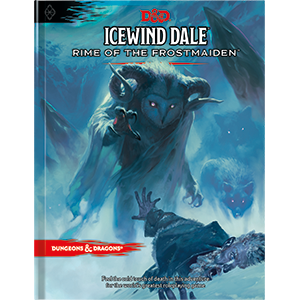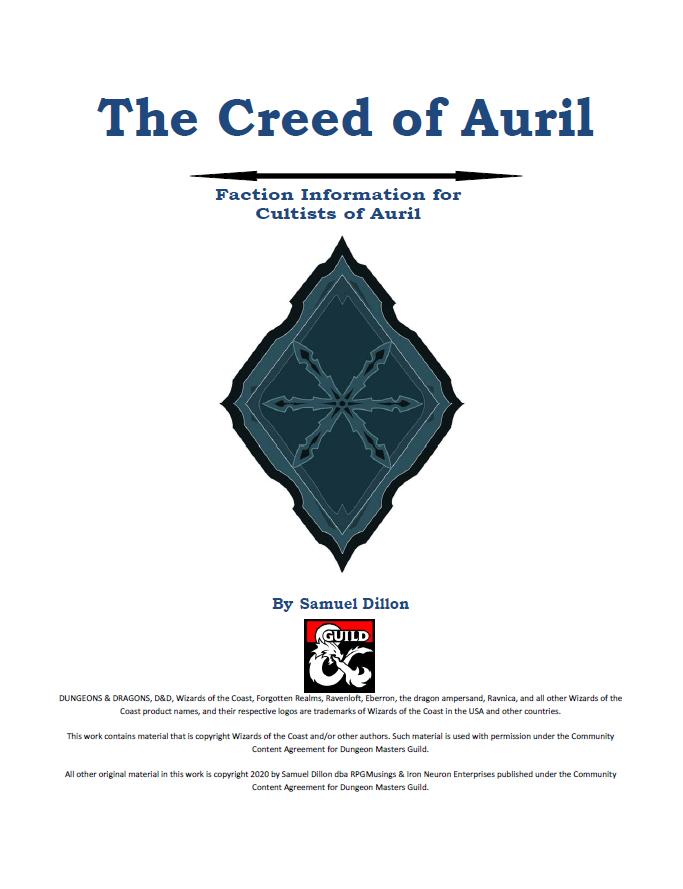Right now there are several discussions of problems with some elements of Rime of the Frostmaiden going around various social media outlets. Since I am running the adventure I decided to provide my thoughts and ideas on how to address some of the issues that have been brought forth. The issue I will address in this post is Why Would a Good Leader Allow Humanoid Sacrifices?

Why Would a Good Leader Allow Sacrifices?
This is a question I have seen asked in multiple places now, and usually it is about a specific person: Duvessa Shane, the Speaker of Bryn Shander. But first let’s look at the alignments of all of the Speakers and other mentioned figures in Ten Towns. A quick skim of chapter 1 will give us a good idea of exactly how many good aligned NPCs there are in Ten Towns:

Out of 43 NPCs listed in chapter 1 of the book, a full 32 of them are good aligned and 11 of those are listed as lawful good. So this question shouldn’t be reduced down only to Duvessa Shane… why would any of the good aligned folks in Ten Towns allow for humanoid sacrifice?
This question is also dangerously close to starting the “Alignment! God God! What is it good for?“ argument/discussion. What does alignment even mean? Does it determine a PC’s behavior? What if I have my PC act in a way that goes against the DM’s idea of a person with this alignment? Should I reward players who roleplay the ideal depiction of an alignment? Should I punish players who have their PC ignore or go against their alignment?
Look, I really don’t intend to have that conversation in this post… but since the original question itself is about Lawful Good or Good Aligned leaders in Ten Towns, well, I guess I have to address it from an alignment perspective. And honestly, it’s a fair question, so Why would ANY of the good aligned people, but especially the leaders in Ten Towns, allow humanoid sacrifice? Here is my answer.
- Lawful. If random/fair sacrificial lotteries are the law of the land, a lawful ruler can easily justify the action. Plenty of individuals have a moral code that focuses on the rule of law rather than the spirit of the law. In D&D this is sometimes illustrated by the trope of the lawful good paladin who cannot abide any breaking of laws no matter how objectively unjust the law may be – often reviled as lawful-stupid. This is usually something laughed at and players who play a paladin this way may be cajoled and taunted about their PC’s behavior. But let’s be honest – a lawfully aligned individual has, at the very least, a tendency to follow the rules and will expect others to do so as well. If they aren’t the ones making the rules, all the better and easier to excuse distasteful or uncomfortable outcomes. Some will find this to be a rather thin argument but when taken in combination with the following 4 points, a compelling case is made.
- The good of the many. If the Speaker/leader/authority figure believes that the sacrifice of one betters the survival of the many, then a lawful aligned person is not as conflicted by the single humanoid sacrifice as one might think. If a just leader truly feels that “the good of the many outweighs the good of the few or the one” then they can easily resolve the seemingly discordant duties of protecting all of the citizens in their care while simultaneously allowing one of the citizens to be killed. This is, of course, a very utilitarian ethical stance, but it does lead to a conclusion that supports the sacrifices in Ten Towns.
- Desperate times. Let’s face it, Icewind Dale is in the midst of a climate catastrophe. The people of Ten Towns are living through a horrifically devastating weather pattern that is threatening all of the citizens therein. People perform desperate acts during desperate times, and so it is entirely possible for a good aligned leader to have fallen far enough down the pit of despair to actually approve, or at least understand the reasoning of, such sacrifices. Do not discount the lengths to which some people will go when faced with overwhelming hopelessness and anguish.
- Normalizing the abnormal. Along with the above reasoning comes the horribleness of normalizing the day-to-day events that occur during a calamitous or tragic situation, especially one that is chronically present. Remember, the everlasting winter and extended darkness in Icewind Dale has been ongoing for two years. TWO YEARS! The introduction of chronic low level stressors (extreme cold, resource scarcity) punctuated with devastating high level stress-inducing events (avalanches, sacrifices) causes people to go into safety and vigilance mode. In this mindset people do what they can to survive, and that often includes ignoring or tacitly allowing dreadful practices to continue. In relatively short order these horrendous acts become just part of every day life and are accepted as such. In essence, the bad acts now feel more normal than the life lived in Ten Towns before the Frostmaiden started her nightly voyage across the sky.
- Pantheistic morals. Much of the way we see the world is informed by the monotheistic focus of the major religions in the world today. As a result it is very difficult for someone raised in the modern monotheistic world to put themselves in the shoes of a person living in a pantheistic world. I find it completely reasonable that a desperate population might begin to believe that they can appease a deity by sacrificing people, things, or comfort. In a pantheistic world it makes all the more sense that a good leader would try to acquiesce to Auril’s desires if the other deities in the setting have gone silent, unresponsive, or inactive. In other words, if it is reasonable that more than one deity can influence the world and the only deity that seems to have power in the region might be satisfied with a sacrificial ritual, then a good leader would protect their people by sacrificing living things. These are people who will also be praying and sacrificing to other gods in the pantheon even as they try to appease Auril. They might be worshiping Lathander to ask for a rebirth of spring and summer, praying to Mystra to grant someone the knowledge to counteract Auril’s spell, imploring Selune to influence Auril’s flight path, entreating Torm to grant the Ten Towners the courage to continue on through yet another winter, appealing to Helm for protection from the ever-present elements, and begging Ilmater for the strength to endure another month of ice and snow.
Alright, that’s all I have for you today!
We have now finished a session 0 and sessions 1 & 2 of my Rime campaign – I’ll fill you in on some houserules and changes in my next few posts. If you want to watch session 1 and 2, they can be found here: Endless Night RotF session 1 and Endless Night RotF session 2.
You can support my work by checking out my latest DMsGuild release – it’s called The Creed of Auril and contains information on the Church of Auril and descriptions of cult beliefs, behaviors, membership, and rationale. It also has 16 new spells, 2 new magic items, 6 new NPC/creature statblocks, and over 12 detailed ways to add cultists and cult activity to the area. The product is $4.99 on the DMs Guild and you can purchase it by clicking here: The Creed of Auril
You can also support me and my co-creators by purchasing Scientific Secrets of Icewind Dale – new and challenging creatures and lore for your arctic D&D game: Scientific Secrets of Icewind Dale on the DMsGuild
Until next time, I wish you good gaming!
![]() ~DMSamuel
~DMSamuel


